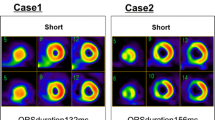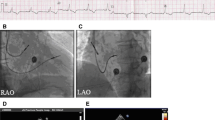Abstract
Objective
Washout rate of iodine-123 metaiodobenzylguanidine (MIBG) myocardial scintigraphy is correlated with the degree of myocardial damage. The aim of this study is to ascertain whether there is any relationship between QRS complex duration at right ventricle (RV) pacing and the degree of myocardial damage assessed by I-123 MIBG myocardial scintigraphy in normally functioning left ventricle.
Methods
The study included 22 patients (10 men and 12 women, ranging in age from 48 to 89 years), with atrioventricular (AV) block (n = 15) and sick sinus syndrome (n = 7). All patients had baseline QRS duration of less than 120 ms and received implantation of a DDD-mode permanent pacemaker. Iodine-123 MIBG myocardial scintigraphy was performed before the pacemaker implantation, and QRS duration at RV pacing at a rate of 70 ppm was calculated immediately after the implantation.
Results
With the use of RV pacing, QRS duration was prolonged ranging from 122.4 to 185.6 ms with a mean of 153.2 ± 15.2 ms. Washout rate of I-123 MIBG myocardial scintigraphy (WR) was calculated as ranging from 5.0 to 83.0% with a mean of 44.2 ± 17.5%. There was a strong correlation between WR and QRS duration at RV pacing (r = 0.735, p < 0.001).
Conclusions
It was confirmed that WR of I-123 MIBG was correlated positively with QRS duration at RV pacing. Measurement of QRS duration may be helpful to evaluate the degree of underlying myocardial damage even in the normally functioning left ventricle.

Similar content being viewed by others
References
Imamura Y, Ando H, Mitsuoka W, Egashira S, Masaki H, Ashihara T, et al. Iodine-123 metaiodobenzylguanidina images reflect intense myocardial adrenergic nervous activity in congestive heart failure independent of underlying cause. J Am Coll Cardiol. 1995;26:1594–9.
Suwa M, Otake Y, Moriguchi A, Ito T, Hirota Y, Kawamura K, et al. Iodine-123 metaiodobenzylguanidine myocardial scintigraphy for prediction of response to beta-blocker therapy in patients with dilated cardiomyopathy. Am Heart J. 1997;133:353–8.
Nakata T, Miyamoto K, Doi A, Sasao H, Wakabayashi T, Kobayashi H, et al. Cardiac death prediction and impaired cardiac sympathetic innervation assessed by MIBG in patients with failing and nonfailing hearts. J Nucl Cardiol. 1998;5:579–90.
Arimoto T, Takeishi Y, Niizeki T, Koyama Y, Okuyama H, Nozaki N, et al. Ongoing myocardial damage relates to cardiac sympathetic nervous disintegrity in patients with heart failure. Ann Nucl Med. 2005;19:535–40.
Agostini D, Babatasi G, Manrique A, Saloux E, Grollier G, Potier JC, et al. Impairment of cardiac neuronal function in acute myocarditis: iodine-123-MIBG scintigraphy study. J Nucl Med. 1998;39:1841–4.
Chung MK, Martin DO, Sprecher D, Wazni O, Kanderian A, Carnes CA. C-reactive protein elevation in patients with atrial arrhythmias: inflammatory mechanisms and persistence of atrial fibrillation. Circulation. 2001;104:2886–91.
Issac TT, Dokanish H, Lakkis NM. Role of inflammation in initiation and perpetuation of atrial fibrillation. J Am Coll Cardiol. 2007;50:2021–8.
Sata N, Hamada N, Horinouchi T, Amitani S, Yamashita T, Moriyama Y, et al. C-reactive protein and atrial fibrillation. Is inflammation a consequence or a cause of atrial fibrillation? Jpn Heart J. 2004;45:441–5.
Sabatine MS, Morrow DA, Jablonski KA, Rice MM, Warnica JW, Domanski MJ, et al. Prognostic significance of the centers for disease control/American heart association high-sensitivity c-reactive protein cut points for cardiovascular and other outcomes in patients with stable coronary artery disease. Circulation. 2007;115:1528–36.
Burke AP, Tracy RP, Kolodgie F, Malcom GT, Zieske A, Kutys R, et al. Elevated c-reactive protein values and atherosclerosis in sudden coronary death: association with different pathologies. Circulation. 2002;105:2019–23.
Manolis AS. The deleterious consequences of right ventricular apical pacing: time to seek alternate site pacing. Pacing Clin Electrophysiol. 2006;29:298–315.
Author information
Authors and Affiliations
Corresponding author
Rights and permissions
About this article
Cite this article
Sata, N., Kawano, T., Hamada, N. et al. Predictor of underlying myocardial damage in normally functioning left ventricle with narrow QRS complex: relationship between QRS duration at right ventricle pacing and iodine-123 metaiodobenzylguanidine myocardial scintigraphy. Ann Nucl Med 23, 639–641 (2009). https://doi.org/10.1007/s12149-009-0285-x
Received:
Accepted:
Published:
Issue Date:
DOI: https://doi.org/10.1007/s12149-009-0285-x




